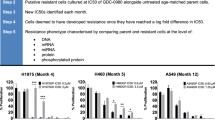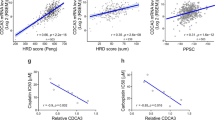Abstract
Purpose
A series of six lung cancer cell lines of different cell origin (including small cell and mesothelioma) were characterized immunohistochemically and the role of a series of protein candidates previously implicated in drug resistance were investigated.
Methods
These include colony-forming and cell growth assays, immunohistochemistry, siRNA knockouts, real-time PCR and western blots.
Results
No correlation was found with AKT, HO-1, HO-2, GRP78, 14-3-3zeta and ERCC1 levels and cisplatin nor oxaliplatin cytotoxicity, but an association was observed with levels of the enzyme, dihydrodiol dehydrogenase (DDH); an enzyme previously implicated in the development of platinum resistance. The relationship appeared to hold true for those cell lines derived from lung epithelial primary tumors but not for the neuroendocrine/small-cell and mesothelioma cell lines. siRNA knockouts to DDH-1 and DDH-2 were prepared with the cell line exhibiting the greatest resistance to cisplatin (A549) resulting in marked decreases in the DDH isoforms as assessed by real-time PCR, western blot and enzymatic activity. The DDH-1 knockout was far more sensitive to cisplatin than the DDH-2 knockout.
Conclusion
Thus, sensitivity to cisplatin appeared to be associated with DDH levels in epithelial lung cancer cell lines with the DDH-1 isoform producing the greatest effect. Results in keeping with transfection experiments with ovarian and other cell lines.



Similar content being viewed by others
References
Ozols RF, William SD (1989) Testicular cancer. Curr Probl Cancer 13:287–335
Loehrer PJ, Einhorn LH (1984) Drugs five years later, cisplatin. Ann Intern Med 100:704–713
Pinto A, Lippard SJ (1985) Binding of the antitumor drug cisdiamminedichloroplatinum (II) (cisplatin) to DNA. Biochem Biophys Acta 780:167–180
Timmer-Bosscha H, Mulder NH, deVries EGE (1992) Modulation of cisdiamminedichloroplatinum (II) resistance: a review. Br J Cancer 66:227–238
Andrews PA, Velury S, Mann SC, Howell SB (1992) Cisdiamminedichloroplatinum (II) accumulation in sensitive and resistant human ovarian cells. Cancer Res 48:68–73
Mamenta EL, Poma EE, Kaufman WK, Delmastro DA, Grady HL, Chaney SG (1994) Enhanced replicative bypass of platinum: DNA adducts in cisplatin resistant human ovarian carcinoma cell lines. Cancer Res 54:3500–3508
Christen RJ, Jekunen AP, Jones JA, Thiebaut F, Shalinsky DR, Howell SB (1993) In Vitro modulation of cisplatin accumulation in human ovarian cells by pharmacological alteration of microtubules. J Clin Invest 92:431–440
Parekh HK, Simpkins H (1995) The differential expression of cytokeratin 18 in cisplatin-sensitive and resistant human ovarian adenocarcinoma cells and its association with drug sensitivity. Cancer Res 55:203–5206
Andrews PA, Albright KD (1992) Mitochondrial defects in cisdiamminedichloroplatinum (II)—resistant human ovarian carcinoma cells. Cancer Res 52:1895–1901
Isonishi S, Jekunen AP, Hom DH, Eastman A, Edelstein PS, Thiebaut FB, Christen RD, Howell SB (1992) Modulation of cisplatin sensitivity and growth rate of an ovarian carcinoma cell line by bombesin and tumor necrosis factor. J Clin Invest 90:1436–1442
Mann SC, Andrews PA, Howell SB (1992) Modulation of cis-diamminedichloroplatinum (II) accumulation and sensitivity by forkolin: a 3 isobutyl, 1-methylxanthine in sensitive and resistant human ovarian cells. Int J Cancer 48:866–872
Moorehead RA, Singh G (2000) Influence of the proto-oncogene c-fos on cisplatin sensitivity. Biochem Pharmacol 59:337–345
Parekh HK, Simpkins H (1996) Cross resistance and collateral sensitivity to natural product drugs in cisplatin-sensitive and -resistant rat lymphoma and human ovarian carcinoma cells. Cancer Chemother Pharmacol 37:457–462
Chen Z-S, Mutoh M, Sumizawa T, Furukawa T, Haraguchi M, Tani A, Saijo N, Kondo T, Akiyami S (1998) An active efflux system for heavy metals in cisplatin-resistant human KB carcinoma cells. Exp Cell Res 240:312–320
Parekh HK, Simpkins H (1996) Species-specific differences in taxol transport and cytotoxicity against human and rodent tumor cells: evidence for an alternative transport system. Biochem Pharmacol 51:301–311
Deng HB, Adikari M, Parekh HK, Simpkins H (2002) Increased expression of dihydrodiol dehydrogenase induces resistance to cisplatin in human ovarian carcinoma cells. J Biol Chem 277:15035–15043
Smithgall TE, Harvey RG, Penning TM (1986) Regio and stereospecificity of homogeneous 3 alpha hydroxysteroid-dihydrodiol dehydrogenase for trans-dihydrodiol metabolites of polycyclic aromatic hydrocarbons. J Biol Chem 261:6184–6191
Smithgall TE, Harvey RG, Penning TM (1988) Oxidation of the trans-3′4-dihydrodiol metabolites of the potent carcinogen 7,12 dimethylbenz(a)anthracene and other benz(a)anthracene derivatives by 3 alpha hydrosteroid dehydrogenase: effects of methyl substitution on velocity and stereochemical course of trans-dihydrodiol oxidation. Cancer Res 48:1227–1232
Smithgall TE, Harvey RG, Penning TM (1988) Spectroscopic identification of orthoquinones as the products of polycyclic aromatic trans-dihydrodiol oxidation catalyzed by dihydrodiol dehydrogenase: a potent route of proximate carcinogen metabolism. J Biol Chem 263:1814–1820
Ax W, Soldan M, Koch L, Maser E (2000) Development of duanorubicin resistance in tumor cells by induction of carbonyl reductase. Biochem Pharmacol 59:293–300
Ciacco PJ, Stuart JE, Tew KD (1993) Overproduction of a 37.5 kDa cytosolic protein structurally similar to prostaglandin F synthase in ethacrynic acid-resistant human colon cells. Mol Pharmacol 43:845–853
Hsu N-Y, Ho H-C, Chow K-C, Lin T-Y, Shih C-S, Wang L-S, Tsai C-M (2001) Overexpression of dihydrodiol dehydrogenase as a prognostic marker of non-small cell lung cancer. Cancer Res 61:2727–2731
Raymond E, Faure S, Chaney S, Wojnarowski-Cvithovic E (2002) Cellular and molecular pharmacology of oxaliplatin. Mol Cancer Ther 1:227–235
Hector S, Bolanowska-Higdon W, Zolanowicz J, Hitt S, Pendyla L (2001) In vitro studies on the mechanisms of oxaliplatin resistance. Cancer Chemother Pharmacol 48:398–406
Pelosi G, Fraggetta F, Pasini F, Maisonneuve P, Sonzogni A, Iannucci A, Terzi A, Bresaola E, Valduga F, Lupo C, Viale G (2001) Immunoreactivity for thyroid transcription factor-1 in Stage 1 non-small cell carcinomas of the lung. Am J Surg Pathol 25:363–372
Lee T-C, Ho I-C (1996) Expression of heme oxygenase in arsenic-resistant human lung adenocarcinoma cells. Cancer Res 54:1660–1664
Lee MW, Kim DS, Min NY, Kim HT (2008) AKT-1 inhibition by RNA interference sensitizes human non-small cell lung cancer cells to cisplatin. Int J Cancer 122:2380–2384
Kweon M-H, Adikhari V-M, Lee J-S, Mukhtar H (2006) Constitutive overexpression of Nrf2-dependent Heme oxygenase-1 in A549 cells contributes to resistance to apoptosis induced by Epigallocatechin 3-gallate. J Biol Chem 281:33761–33772
Fan T, Li R, Todd NW, Qui Q, Fang H-B, Wang H, Shen J, Zhao R-Y, Caraway NP, Katz RL, Stass SA, Jiang F (2007) Upregulation of 14-3-3zeta in lung cancer and its implication as a prognostic and therapeutic target. Cancer Res 67:7901–7906
Uramoto H, Sugio K, Oyama T, Nakata S, Ono K, Yoshimatsu T, Morita M, Yasumoto K (2005) Expression of endoplasmic reticulum molecular chaperone Grp 78 in human lung cancer and its clinical significance. Lung Cancer 49:55–62
Dabholkar M, Vionnet J, Bostick-Bruton F, Yu JJ, Reed E (1994) Messenger RNA levels of XPAC and ERCC1 in ovarian cancer tissue correlate with response of platinum-based chemotherapy. J Clin Invest 94:703–708
Hwang IG, Ahn MJ, Park BB, Ahn YC, Han J, Lee S, Kim J, Shim YM, Ahn JS, Park K (2008) ERCC1 expression as a prognostic marker in N2(+) non-small cell lung cancer patients treated with platinum-based neoadjuvant concurrent chemoradiotherapy. Cancer 113:1379–1386
Desmond JC, Mountford JC, Drayson MT, Walker EA, Hewison M, Ride JP, Luong QT, Hayden RE, Vanin EF, Bunce CM (2003) The aldo-keto reductase AKR1C3 is a novel suppressor of cell differentiation that provides a plausible target for the non cyclo-oxygenase-dependent antineoplastic actions of nonsteroidal anti-inflammatory drugs. Cancer Res 63:505–512
Deng HB, Adikari M, Parekh HK, Simpkins H (2004) Ubiquitous induction of resistance to platinum drugs in human ovarian, cervical, germ cell and lung carcinoma tumor cells overexpressing isoforms 1 and 2 of dihydrodiol dehydrogenase. Cancer Chemother Pharmacol 54:301–307
Chen J, Adikari M, Pallai R, Parekh HK, Simpkins H (2008) Dihydrodiol dehydrogenase regulates the generation of reactive oxygen species and the development of cisplatin resistance in human ovarian carcinoma cells. Cancer Chemother Pharmacol 61:979–987
Fernandez PM, Tabbara SO, Jacobs LK, Manning FC, Tsangaris TN, Schwartz AM, Kennedy KA, Patierno SR (2000) Overexpression of the glucose regulated stress gene GRP78 in malignant but not benign breast lesions. Breast Cancer Res Treat 59:15–26
Tang D, Khuleque MA, Jones EL, Theriault JR, Li C, Wong WH, Stevenson MA, Calderwood SK (2005) Expression of heat shock protein and heat shock protein messenger ribonucleic acid in human prostate carcinoma in vitro and in tumors in vivo. Cell Stress Chaperones 10:46–58
Fogelman DR, Kopetz S, Eng C (2008) Emerging drugs for colorectal cancer. Expert Opin Emerg Drugs 13:629–642
Hung J-J, Chow K-C, Wang H-W, Wong L-S (2006) Expression of dihydrodiol dehydrogenase and resistance to chemotherapy and radiotherapy in adenocarcinoma cells of the lung. Anticancer Res 26:2949–2956
Acknowledgments
The work was supported by the National Institutes of Health [Grant R01-CA098804, Funding Agency: National Cancer Institute].
Conflict of interest statement
None.
Author information
Authors and Affiliations
Corresponding author
Rights and permissions
About this article
Cite this article
Chen, J., Emara, N., Solomides, C. et al. Resistance to platinum-based chemotherapy in lung cancer cell lines. Cancer Chemother Pharmacol 66, 1103–1111 (2010). https://doi.org/10.1007/s00280-010-1268-2
Received:
Accepted:
Published:
Issue Date:
DOI: https://doi.org/10.1007/s00280-010-1268-2




